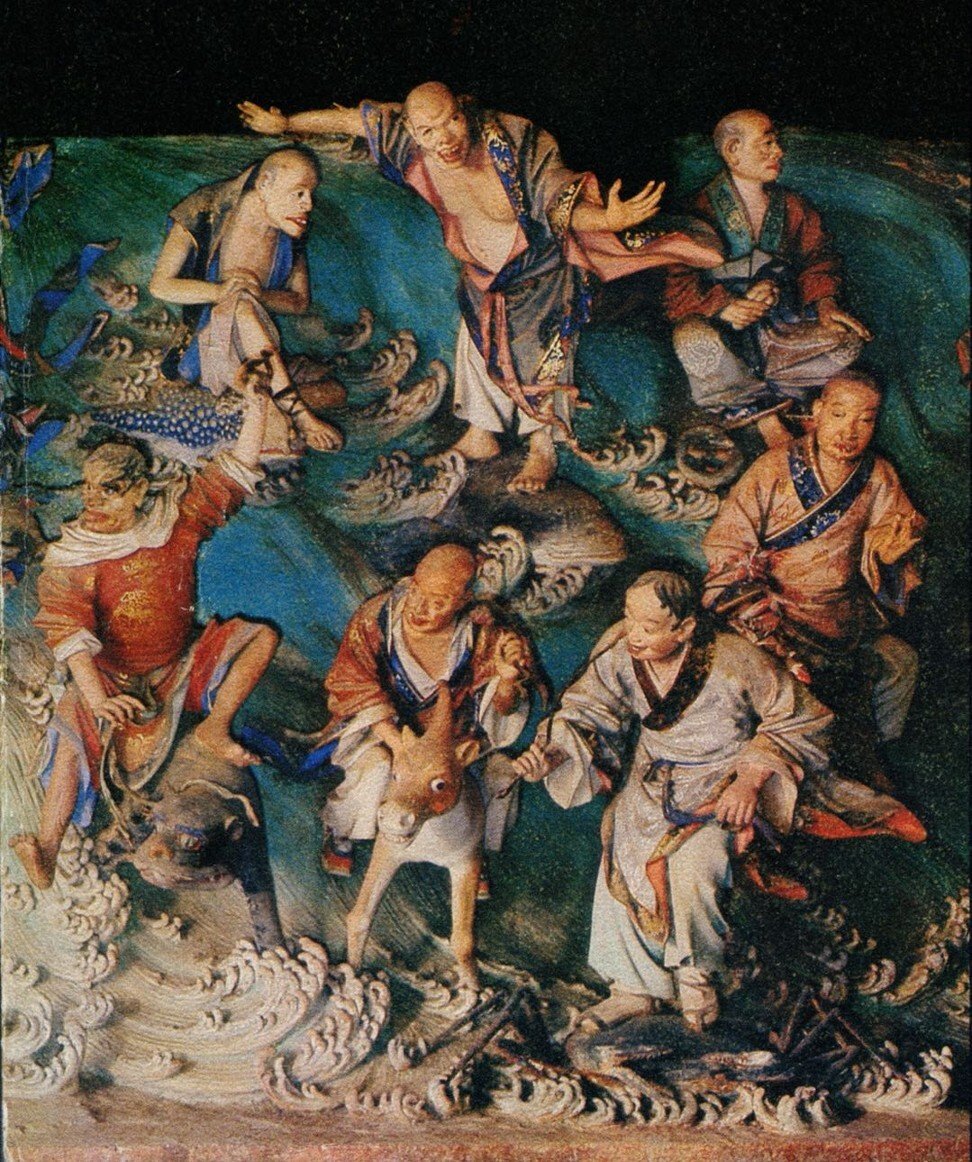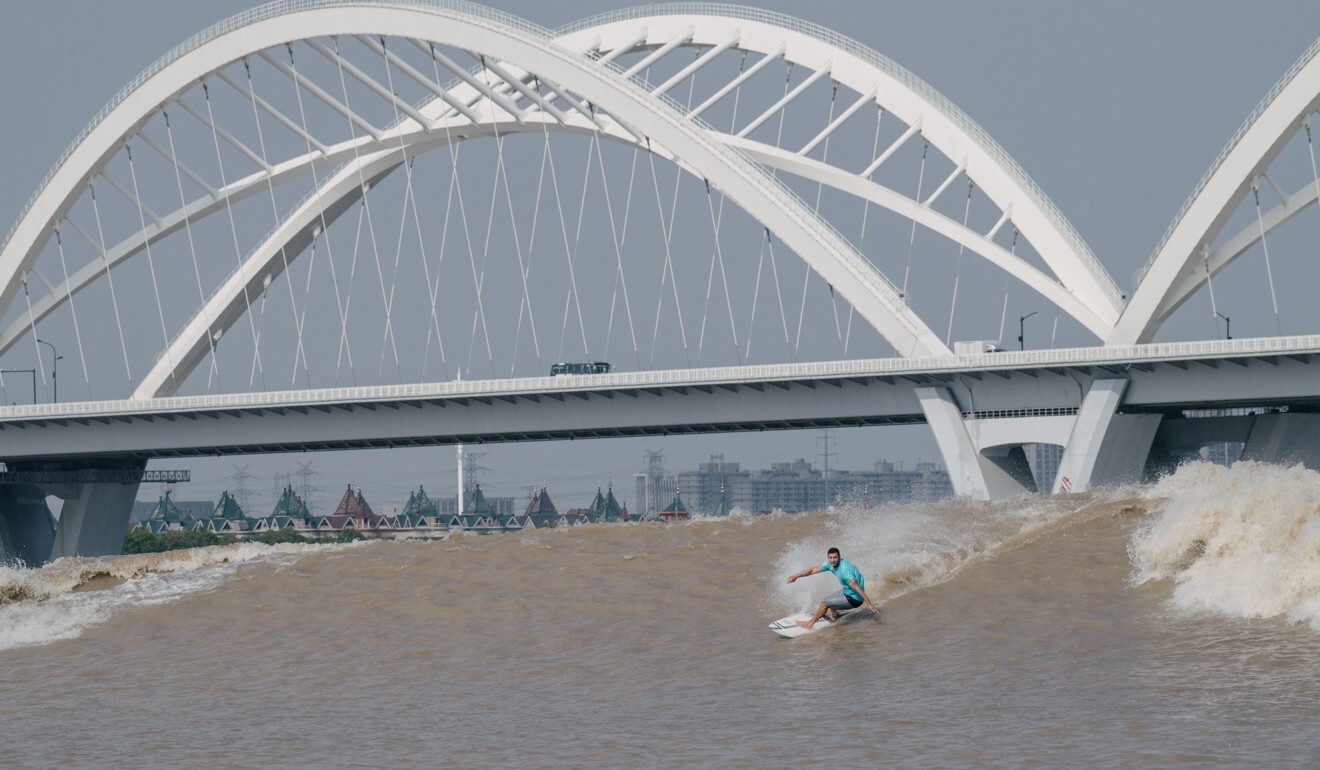
Did surfing start in China 1,000 years ago? Ancient poems and art show surfers riding Hangzhou’s bore as ‘children of the tide’
- A small sculpture of a surfer riding a giant fish leads to discovery of surfing competitions in Hangzhou during the Song dynasty
- Though China may have been one of the first countries to ride waves, surfing belongs to no nation, says ‘Children of the Tide’ author
Surfing may have started in China, long before anyone elsewhere picked up a board to ride a wave.
The origin of surfing is usually traced to Polynesia, but research by Italian surfing historian, writer and coach Nicola “Nik” Zanella, points at a wave-riding culture in China that existed at least since the Song dynasty (960AD to 1279). Zanella, who graduated in Chinese studies and learned Mandarin in China, came across descriptions of wave riding in classical Chinese literature, and then told the story in a self-published book Children of the Tide.
The birthplace of Chinese wave riding was not a tropical coast, but the fierce waters of the world’s largest tidal bore on the Qiantang River in Hangzhou, where the tide drives waves up to 5m high far up the river. Now an extreme surfing event – Battle at the Silver Dragon – is held there, but the surfers taking part may not know that the Chinese Emperor once watched locals ride these same waves, and poets wrote verses about their skill and courage.
In 2006, in a Buddhist temple in Kunming, Zanella saw a bas-relief made at the end of the 19th century. It depicted a group of arhats, beings who gained an insight into enlightenment, among the waves. One arhat stood out.
“The guy was standing up, his pose was exactly what we teach – back foot flat, front foot at a 45-degree angle, looking 5m in front of the board. And his face – he looked stoked,” said Zanella, adding he was riding a giant fish.
The Zanella asked the temple abbot for more information.
The lonely surfer: the hunt for North Korea’s first break
The abbot didn’t know what chong lang [surfing in Chinese] meant. The abbot replied: “These people lived in Hangzhou. They were called nong chao er [children of the tide/those who play with the tide].”
Zanella then “dived into 5,000 years of Chinese literature” to seek out the nong chao er. The search led Zanella to a story called Contemplating the Tide, by a Song dynasty poet Zhou Mi.
Zhou describes a scene from the Mid-Autumn Festival, of the Song Emperor and the nobles watching a spectacle at the Qiantang River tidal bore in Hangzhou, China’s capital at the time.

In the scene that Zanella translated, The Emperor was treated to something that bore an uncanny resemblance to modern surfing, down to the hairstyles and body art, taking place almost a thousand years ago.
“Hundreds of brave watermen … with unfastened hair and tattoos, holding coloured flags, race to the water … they paddle towards the oncoming waves … then they leap up and perform a hundred manoeuvres without getting the tail of their flags even slightly wet. This is how they show off their skill. Hence the nobles reward them with silver prizes,” Zhou wrote.
Zanella quoted two literary works that suggest nong chao er stood up on their boards. Song writer Wu Zimu, in Dreaming over a Millet Bowl, describes them as doing ta lang. The verb ta means to step on, tread on or stamp on. Lang is wave.

Zhou, in Recollections of Wulin Garden, uses the verb ta again, adding that nong chao er were treading on hun mu, meaning drifting wood, or uncut, rough wood.
“They gather in a group of a hundred, holding coloured flags, and compete in treading waves. They head straight to the river mouth to welcome the tide,” Zhou wrote. “Moreover, there’s some who tread on drifting wood … performing hundreds of water tricks, having fun, each displaying great mastery.”
Bao Xuping, the organiser of Battle of the Silver Dragon, said that the waves in the bore can reach speeds of almost 30km an hour.

Bao added that most of the Song nong chao er would have been body surfing and body boarding, but some were standing up.
He quoted another piece of Song poetry – Daily Memories of Observing the Tide – by Pan Lang, which said tao tou li – tao tou is head of the wave, li means to stand.
Bao learned from local fisherman of the Qiantang delta that surfing for fun evolved from local fishing methods.
“The tide on the Qiantang brings ocean fish into the river,” he said. “These are called chao tou yu [fish from the head of the tide] and are considered to be auspicious and delicious.”
The ancient fishermen paddled out into the tidal bore on pieces of wood or bamboo rafts and “using something that looks like butterfly nets”, scooped the fish out of the waves.
Sam Bleakely, European long board champion and surf filmmaker familiar with Chinese surfing scene, said: “Riding waves is a natural way of coastal communities to play with the sea. Different forms of wave riding have popped up everywhere from ancient Peru to West Africa, and all regions in the Pacific.”

Zanella echoed Bleakley: “Wave riding does not belong to any nation. It has been invented and reinvented in many places and called a lot of different names. It is humanity’s commonwealth, to be enjoyed by everyone.”.
He says that surfing the Qiantang bore regularly fell afoul of the Song authorities.
Zanella translated the 1065 edict by Hangzhou Governor Cai Xiang – “Prohibition of Playing with the Tide” – where the Governor admonishes the wave riders who “show off” their skills above “the abyss where fishes and dragons roam”. Not only would their souls “go straight to the underworld” while their wives and children were “crying and staring at water surface”, dying while treading waves was “ending life not according to natural fate”.

Such bans did not seem to have had much of an effect on the nong chao er, said Zanella. But the Mongols, who defeated the Song and established the Yuan dynasty in 1271, did manage to put a downer on the Song surfing scene. According to Zanella, with the advent of the Yuan, wave treading all but vanished from literature.
Yet, playing with the tide lived on, said Zanella. “We know that the Qiantang bore was surfed until the 1980s, on long, pointy pieces of wood, up to 3m long.”
Now only official competitors at Battle at the Silver Dragon are permitted to surf the Qiantang bore, but in the mid 2000s wave-riding culture in China was reborn in tropical Hainan. Now 5,000 people surf there every day, according to surf entrepreneur Darci Liu, China’s first professional surfer.
Liu belongs to the first generation of modern Chinese surfers and she has been watching the local youngsters get better and better. Said Liu: “If someone from Australia or Hawaii comes here to Hainan and sees them surf, they will say – these kids have skills!”
Just like the onlookers once said about the nong chao er.

